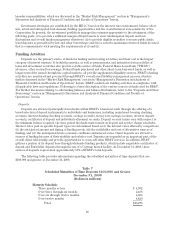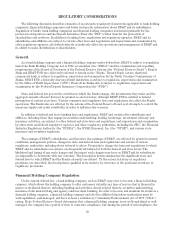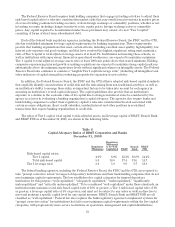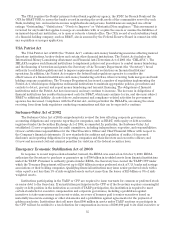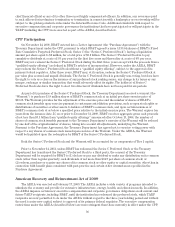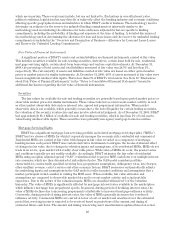BB&T 2008 Annual Report Download - page 36
Download and view the complete annual report
Please find page 36 of the 2008 BB&T annual report below. You can navigate through the pages in the report by either clicking on the pages listed below, or by using the keyword search tool below to find specific information within the annual report.chief financial official or any of its other three most highly compensated officers. In addition, any severance paid
to such officers for involuntary termination or termination in connection with a bankruptcy or receivership will be
subject to the golden parachute rules under the Internal Revenue Code. Additional standards with respect to
executive compensation and corporate governance for institutions that have participated or will participate in the
TARP (including the CPP) were enacted as part of the ARRA, described below.
CPP Participation
On November 14, 2008, BB&T entered into a Letter Agreement (the “Purchase Agreement”) with the
Treasury Department under the CPP, pursuant to which BB&T agreed to issue 3,133.64 shares of BB&T’s Fixed
Rate Cumulative Perpetual Preferred Stock, Series C (the “Series C Preferred Stock”), having a liquidation
amount per share equal to $1 million, for a total price of $3.1 billion. The Series C Preferred Stock is to pay
cumulative dividends at a rate of 5% per year for the first five years and thereafter at a rate of 9% per year.
BB&T may not redeem the Series C Preferred Stock during the first three years except with the proceeds from a
“qualified equity offering” (as defined in BB&T’s articles of incorporation). However, under the ARRA, BB&T
may redeem the Series C Preferred Stock without a “qualified equity offering”, subject to the approval of its
primary federal regulator. After three years, BB&T may, at its option, redeem the Series C Preferred Stock at
par value plus accrued and unpaid dividends. The Series C Preferred Stock is generally non-voting, but does have
the right to vote as a class on the issuance of any preferred stock ranking senior, any change in its terms or any
merger, exchange or similar transaction that would adversely affect its rights. The holder(s) of Series C
Preferred Stock also have the right to elect two directors if dividends have not been paid for six periods.
As part of its purchase of the Series C Preferred Stock, the Treasury Department received a warrant (the
“Warrant”) to purchase 13.9 million shares of BB&T’s common stock at an initial per share exercise price of
$33.81. The Warrant provides for the adjustment of the exercise price and the number of shares of BB&T’s
common stock issuable upon exercise pursuant to customary anti-dilution provisions, such as upon stock splits or
distributions of securities or other assets to holders of BB&T’s common stock, and upon certain issuances of
BB&T’s common stock at or below a specified price relative to the initial exercise price. The Warrant expires ten
years from the issuance date. If, on or prior to December 31, 2009, BB&T receives aggregate gross cash proceeds
of not less than $3.1 billion from “qualified equity offerings” announced after October 13, 2008, the number of
shares of common stock issuable pursuant to the Treasury Department’s exercise of the Warrant will be reduced
by one-half of the original number of shares, taking into account all adjustments, underlying the Warrant.
Pursuant to the Purchase Agreement, the Treasury Department has agreed not to exercise voting power with
respect to any shares of common stock issued upon exercise of the Warrant. Under the ARRA, the Warrant
would be liquidated upon the redemption by BB&T of the Series C Preferred Stock.
Both the Series C Preferred Stock and the Warrant will be accounted for as components of Tier 1 capital.
Prior to November 14, 2011, unless BB&T has redeemed the Series C Preferred Stock or the Treasury
Department has transferred the Series C Preferred Stock to a third party, the consent of the Treasury
Department will be required for BB&T to (1) declare or pay any dividend or make any distribution on its common
stock (other than regular quarterly cash dividends of not more than $0.47 per share of common stock) or
(2) redeem, purchase or acquire any shares of its common stock or other equity or capital securities, other than in
connection with benefit plans consistent with past practice and certain other circumstances specified in the
Purchase Agreement.
American Recovery and Reinvestment Act of 2009
The ARRA was enacted on February 17, 2009. The ARRA includes a wide variety of programs intended to
stimulate the economy and provide for extensive infrastructure, energy, health, and education needs. In addition,
the ARRA imposes certain new executive compensation and corporate governance obligations on all current and
future TARP recipients, including BB&T, until the institution has redeemed the preferred stock, which TARP
recipients are now permitted to do under the ARRA without regard to the three year holding period and without
the need to raise new capital, subject to approval of its primary federal regulator. The executive compensation
restrictions under the ARRA (described below) are more stringent than those currently in effect under the CPP,
36


